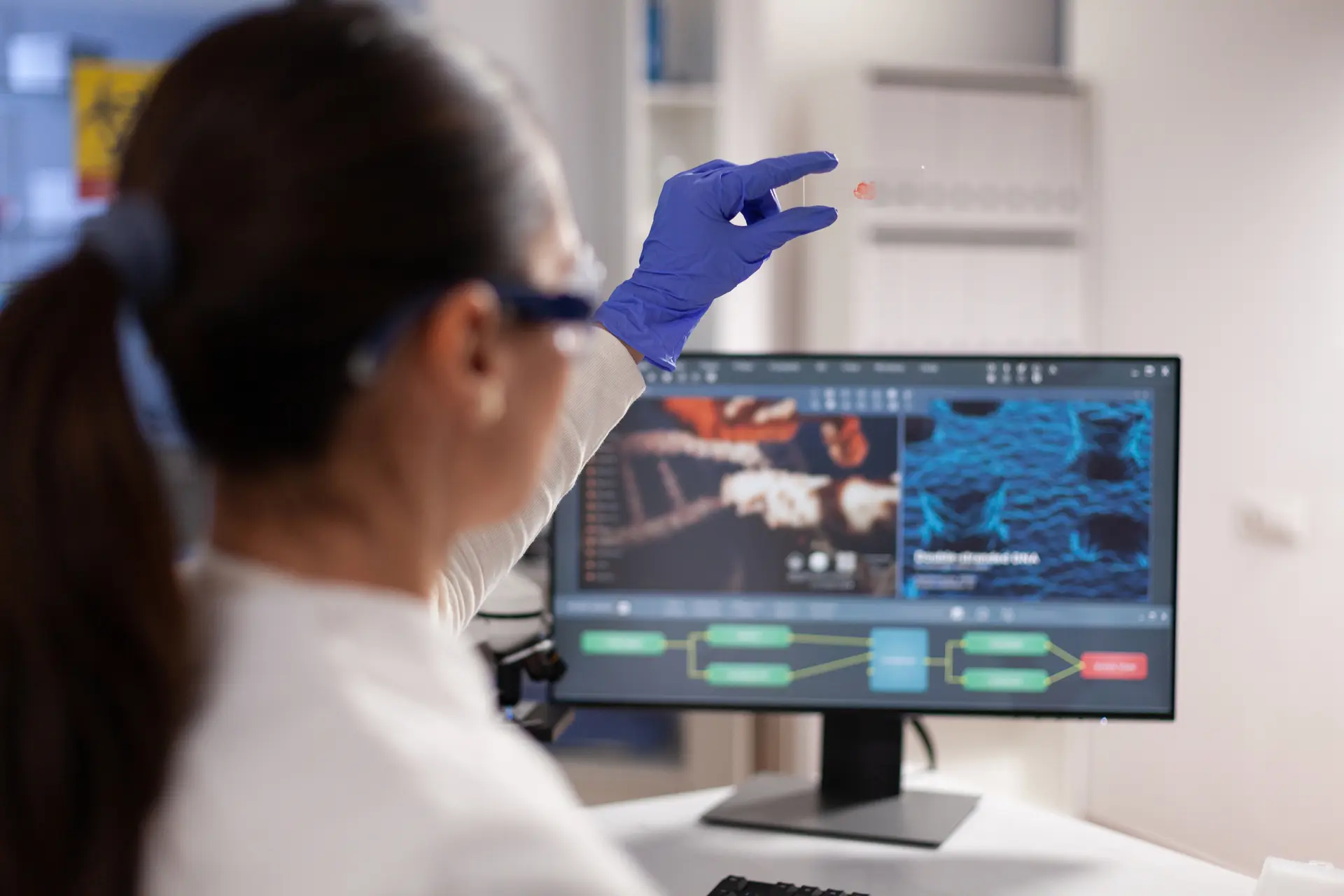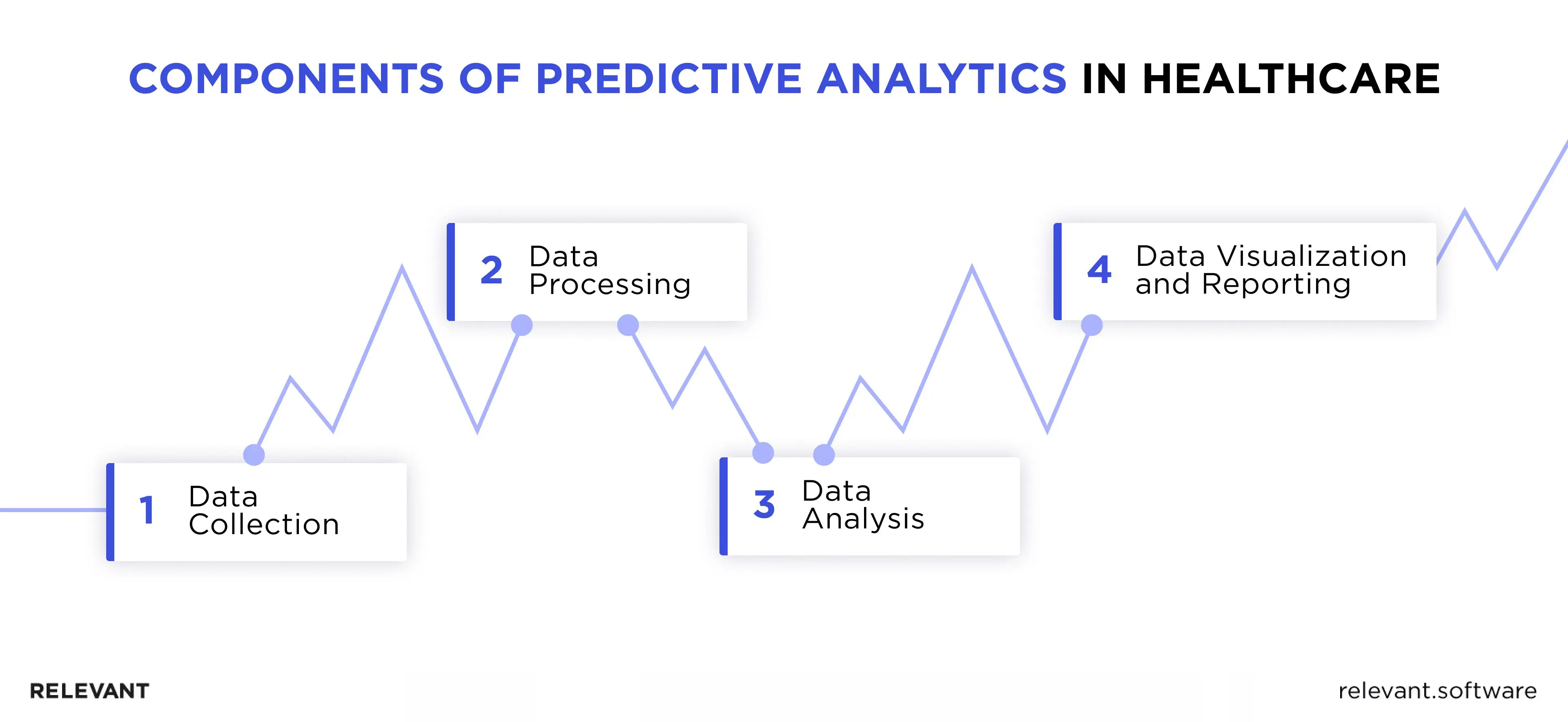Predictive Analytics in Healthcare: Major Benefits and Applications

In an increasingly digital world, a pioneering strategy, predictive analytics, has emerged at the crossroads of healthcare and technology. This powerful tool deploys machine learning algorithms and statistical methods to sift through healthcare data, forecasting future outcomes. Its application spans from preventing diseases to managing hospital workflows, demonstrating the importance of predictive analytics’ application in healthcare.
However, like any instrument, it’s imperative to grasp the pros and cons of predictive analytics in healthcare to apply it effectively. Remember, comprehension is the first step toward effective implementation. Consequently, we propose you dedicate a moment to examine this article.
What is Predictive Analytics in Healthcare? Key Highlights
Predictive analytics in healthcare refers to the application of statistical algorithms and machine learning methodologies aimed at determining future probabilities based on historical data. In other words, it’s about taking what we already know and using it to predict what could happen next.
This is incredibly valuable in healthcare. Imagine being able to anticipate health issues before they become serious or optimize hospital resources by predicting patient influx accurately. Predictive analytics can help achieve these and more.
By mining and analyzing vast amounts of data from electronic health records, genomics, wearables, and even social media, predictive models can offer insights that help clinicians make better, more personalized care decisions. This isn’t about replacing human judgment; instead, it’s about providing healthcare professionals with tools to enhance their capabilities and improve patient outcomes.
Components of Predictive Analytics in Healthcare
Predictive analytics in healthcare rests on a series of interdependent stages that collectively constitute an intricate mechanism designed to make sense of complex health-related data. The four cornerstone components for successfully applying predictive healthcare analytics are Data Collection, Data Processing, Data Analysis, and Data Visualization and Reporting.

Data Collection
The bedrock of predictive healthcare analytics is data collection. This data might stem from electronic health records (EHR), lab results, patient demographics, genomic databases, pharmaceutical research, medical imaging, and patient-generated data from wearable devices or health apps. The diverse scope of these sources enriches the collected data, providing a holistic view of the patient’s health.
Data Processing
Here, the raw data undergoes cleaning, normalization, and transformation to convert it into a format suitable for analysis. This phase might involve handling missing values, removing duplicates, ensuring data consistency, and securing data privacy and integrity. Appropriate data handling is a crucial factor influencing the precision and dependability of the subsequent predictive model.
Data Analysis
Further, the processed data is subjected to various statistical techniques and machine learning algorithms to detect patterns, trends, and correlations. The objective is to identify the relationship between different variables and to construct analytics models capable of predicting future outcomes or behaviors. In essence, this phase embodies the predictive aspect of healthcare predictive analytics.
Data Visualization and Reporting
This process translates the complex statistical outputs into more intuitive visual formats such as graphs, charts, and heatmaps. Such visualizations make the insights accessible to non-technical stakeholders, facilitating informed decision-making and strategic planning. Conversely, reporting helps communicate these findings clearly and concisely to the concerned individuals or parties.
This table provides a more detailed overview of the key components of predictive analytics in healthcare. Each stage is critical for the success of predictive analytics in delivering meaningful and actionable insights.
| Component | Description |
| Data Collection | Gathering vast amounts of raw data from multiple sources like electronic health records (EHRs), medical imaging, genomic data, patient demographics, and wearable devices. |
| Data Cleaning | Removal of inconsistencies, errors, or irrelevant data, resulting in a clean, reliable dataset for analysis. |
| Data Integration | Merging diverse data sets into a coherent format, ensuring its accessibility for analysis. |
| Predictive Modeling | Applying statistical techniques and machine learning algorithms to the data to identify patterns, relationships, and trends. |
| Validation | Ensuring the accuracy and reliability of the predictive models by comparing predicted results with real outcomes. |
| Interpretation | Making sense of the results of predictive models and translating them into actionable insights for decision-making. |
| Implementation | Applying the actionable insights from the predictive models into healthcare processes for improved patient care, operational efficiency, and informed decision-making. |
| Continuous Monitoring | Checking the predictive models’ performance to ensure accuracy and adjust the models as necessary based on new data, changing conditions, or evolving healthcare needs. |
To conclude, the effective use of predictive analytics in healthcare hinges on the adept handling of these integral components. By accomplishing this, healthcare organizations can transform extensive data sets into practical intelligence, thereby sculpting a future where healthcare is more anticipatory, personalized, and efficient.
Benefits of Predictive Analytics in Healthcare
The transformative and far-reaching advantages of using predictive analytics in healthcare sector are undeniable. They include:
- Better Health: Predictive analytics uses patient data and disease trends to prevent health issues, enhancing patient outcomes.
- Customized Care: Predictive analytics devises personalized treatment schemes by considering a patient’s medical past and genetics.
- Efficient Resource Use: This tool anticipates patient influx to improve resource management, shorten wait times, and enhance patient contentment.
- Proactive Care: Analytics detect predispositions to certain conditions, enabling early actions and educational initiatives for health risks.
- Cost Saving: Predictive analytics yield significant savings for patients and providers by preventing redundant procedures.
- Pandemic Preparedness: Disease trend tracking aids in readying for pandemics and rapid disease outbreak response.
- Effective Trials: Predictive tools swiftly identify ideal clinical trial candidates, shortening trial durations and increasing success rates.
- Quality Assurance: Predictive modeling pinpoints areas for healthcare delivery improvement, ensuring the highest care standards.
- Policy Development: Predictive analytics inform population health management, assisting in formulating impactful healthcare policies.
- Fraud Prevention: These models spot billing and claims violations, preventing fraudulent activities and ensuring the healthcare system’s financial honesty.
As you can see, understanding how to use predictive analytics in healthcare is pivotal in enhancing patient outcomes, streamlining resource utilization, and increasing patient engagement.

Patient-Centric Applications of Predictive Analytics in Healthcare
The scope of predictive analytics in healthcare spans extensively into patient-focused areas. It primarily aids in bolstering patient outcomes, tailoring individual care, and refining disease management strategies.
Enhancing Patient Risk Stratification
Predictive analytics contributes remarkably towards stratifying patients based on their risk profiles. Examining extensive patient data can predict individuals likely to develop severe health conditions, thus prompting early intervention. Moreover, it aids in customizing care plans that cater to the individual’s unique health needs, enhancing treatment effectiveness.
Improving Chronic Disease Management
Predictive analytics ability to detect early signs of chronic diseases like diabetes or heart disease allows for timely interventions. Furthermore, physicians can adapt treatment plans by continuously monitoring and controlling disease progression using predictive analytics, resulting in improved patient health over time.
Facilitating Preventive Care
Preventive care is another critical domain where predictive analytics demonstrates immense value. It assists in identifying potential health issues before they develop into serious conditions, encouraging the implementation of preventive measures. This proactive approach to healthcare improves patient health and saves healthcare costs.
Personalizing Treatments
Treatment personalization, a significant step towards precision medicine, is a notable benefit of predictive analytics. By scrutinizing patient data, treatments can be tailored to the individual’s health profile, enhancing therapeutic efficacy. Furthermore, predictive analytics can optimize drug prescriptions by predicting patient response, minimizing side effects, and ensuring optimal treatment results.
Operational Applications of Predictive Analytics in Healthcare
Operational employment of predictive analytics in healthcare represents a powerful tool for enhancing efficiency, streamlining processes, and improving patient care. Some of these applications include:
Optimizing Resource Allocation
Resource allocation is a challenge for many healthcare institutions. Predictive analytics can address this through predictive staffing models, ensuring personnel is optimally utilized. It also enhances equipment and facility utilization by forecasting patient demand, reducing waste, and improving service delivery.
Streamlining Hospital Workflow
Predictive analytics can also be instrumental in managing patient flow. By analyzing admissions, discharges, and transfer patterns, healthcare providers can foresee periods of high demand and plan accordingly. This results in reduced waiting times, improved patient satisfaction, and diminished bottlenecks.
Minimizing Hospital Readmissions
By identifying key factors contributing to readmissions, healthcare providers can implement interventions to reduce them. Predictive models can analyze patient records and highlight high-risk individuals, allowing healthcare providers to take preventative measures. This proactive approach not only enhances patient outcomes but also decreases the financial strain linked with unnecessary readmissions.
Financial Applications of Predictive Analytics in Healthcare
Predictive analytics also brings transformative advantages to the financial sector of the healthcare industry. This section will explore these financial applications in more detail.
Enhancing Revenue Cycle Management
Predictive analytics brings a new level of sophistication to revenue cycle management. It can project future payment behaviors by analyzing historical patient payment patterns and correlating them with demographic and socioeconomic data. This intelligence allows healthcare organizations to implement strategies to mitigate late or non-payments and optimize their billing processes. As a result, it helps improve cash flow, reduce bad debt, and improve overall financial stability.
Reducing Fraud and Waste
Predictive analytics can identify anomalous patterns that indicate fraudulent activities, like overbilling or unnecessary procedures. Leveraging machine learning algorithms, the system can learn from identified fraud cases, constantly enhancing its detection capabilities. The early detection and swift implementation of corrective measures can save millions, safeguarding precious resources for genuine patient care.
Cost Prediction and Containment
Predictive analytics is a valuable tool in a sector where costs can be unpredictable and sky-high. It can forecast the costs of treatments based on numerous variables such as disease complexity, patient’s health status, and historical treatment costs. With these insights, healthcare providers can strategize for cost reduction and containment, ultimately delivering quality care at more affordable prices.

Maximizing predictive analytics in these domains can profoundly impact healthcare organizations’ financial well-being, fostering a more robust and streamlined healthcare system.
Predictive Analytics in Healthcare: Use Cases
Predictive analytics gains substance when inspected through practical applications. Here, we explore predictive analytics in healthcare case study that unleashes technology’s potential:
Oncology Predictive Analytics
Predictive analytics healthcare has become an indispensable tool in early cancer detection in oncology. It empowers oncologists to identify tumors and classify them by their threat level. Using a wide lens, predictive analytics can sift through populations and evaluate risk factors such as age, family history, and lifestyle.
However, the true value unlocks in individual case assessments. By combining computer vision and machine learning, detailed tumor characteristics, like radius, compactness, perimeter, and proximity to organs, can be extracted to categorize tumors as malignant, metastatic, or benign. Predictive analytics can also forecast cancer recurrence in patients by recognizing specific patterns.
In cases like breast cancer, which is currently detected in its early stages only 20% of the time, predictive analytics can significantly enhance the accuracy of early diagnoses. This study demonstrated its potential; the researchers trained a predictive analytics tool with samples from stage 0 breast cancer patients who underwent mastectomies and had over 10 years of medical records. The model could distinguish between aggressive and nonaggressive diseases from 100 micrographs with 96% accuracy – a significant leap from the 70% achieved by human physicians.
Tackling the Opioid Crisis
Predictive analytics has emerged as a formidable weapon in the battle against the global opioid crisis. This epidemic, affecting millions worldwide, has presented an urgent need for innovative solutions, and predictive analytics has risen to the challenge.
Using advanced algorithms, predictive models have been developed to identify individuals at risk of opioid misuse or overdose. These models have accurately tagged high-risk individuals by analyzing an array of data, including prescription history, mental health records, and social determinants of health. Early identification has facilitated timely interventions, helping healthcare providers and public health officials address this crisis more effectively.
Controlling Infectious Diseases
Predictive analytics has demonstrated significant prowess in controlling infectious diseases, reshaping the approach to their prevention, management, and containment. This technology, empowered by machine learning, provides a robust mechanism to anticipate and react to infectious disease outbreaks, even before they reach epidemic or pandemic proportions.
A case in point is BlueDot, a Canadian firm that excels in predictive analytics and artificial intelligence. Remarkably, BlueDot picked up on an unusual cluster of pneumonia cases in Wuhan, raising an alert a full nine days ahead of the World Health Organization’s official announcement of the novel coronavirus.
Additionally, predictive analytics has been invaluable in proactive planning and resource allocation amid the COVID-19 pandemic, providing indispensable insights for crisis management. Analogous models have been used to forecast influenza outbreaks, promoting early detection and bolstering response efficacy.
These cases highlight the versatility and effectiveness of predictive analytics in healthcare. However, we must also mention predictive analytics in healthcare problems.
Predictive Analytics Challenges in Healthcare
Beneath the vast potential of predictive analytics in healthcare lie several challenges. These hurdles must be navigated carefully to reap the full benefits of this transformative technology. Here, we examine the primary problems with predictive analytics in healthcare:

Data Privacy and Ethical Hazards
Patient confidentiality is non-negotiable in healthcare. Predictive analytics, which analyzes extensive personal data, could potentially breach privacy if misused. Additionally, healthcare organizations must adhere to stringent regulations like HIPAA to secure patient data. Furthermore, bias in predictive models presents an ethical concern. Models focusing on fairness and equity must be developed to avoid biased outcomes that could lead to harmful decisions.
Ensuring Data Quality and Integrity
Given the high-stakes nature of healthcare, where human lives are invariably involved, the repercussions of errors are far-reaching. Only complete or consistent data can ensure the reliability of the analytics and result in accurate predictions. Therefore, it is crucial to effectively devise strategies for handling missing or inconsistent data.
Integration with Existing Healthcare Systems
Finally, integrating predictive analytics into the current healthcare systems calls for specialized technical expertise. Such tools must harmoniously function with existing infrastructures to prevent disruption and capitalize on their analytic merits. This integration, complex in nature, may demand a certain resource investment.
In Conclusion
The healthcare sector is undeniably overflowing with data – patient records, medical images, lab tests, research studies, pharmaceutical trials – the volume of information generated is enormous. This data holds the potential to bolster patient care, enhance resource usage, and address global health issues. Yet, this potential often remains unrealized due to a lack of necessary tools or expertise. This is precisely the gap that we at Relevant aim to fill.
We establish partnerships grounded in healthcare software development and IT consultation instead of offering a mere service. Our principle of operation is to comprehend your unique requirements, build tailor-made solutions, and provide constant support. Our team of skilled AI and ML professionals is committed to successfully implementing predictive analytics within your organization, mitigating risks, and amplifying your data’s value.
We’re standing on the verge of a new era where predictive analytics is becoming an integral component of the healthcare domain. This isn’t a matter of “if,” but decisively “when” and “how.” If you’re itching to be an early adopter in the rapidly advancing future of predictive analytics in healthcare, we invite you to reach out to us. Jointly, we can unlock the vast potential hidden in your data, fueling the transformative change your organization is striving for.
Also, read more about The Real Value of Healthcare Scheduling Software Systems and the importance of Digital Twin technology.



